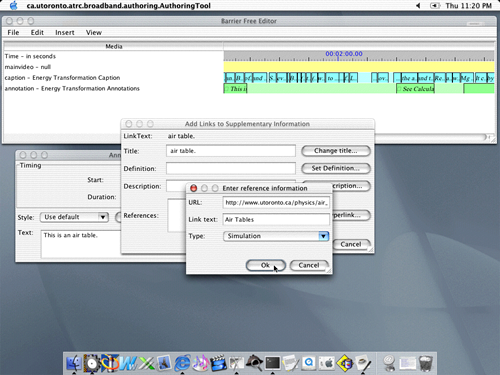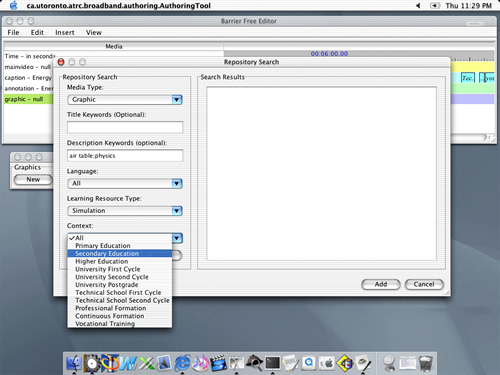
"For people without disabilities, technology
makes things convenient,
for people with disabilities, it makes things possible."
![]()
Deliverables - Tools and Content
Updated August 1, 2002
Authoring Tools
This Java application allows educators and content developers to combine individual learning objects into a multi-layer, interactive presentation. The Authoring Tool can be used to:
- supplement a video presentation with alternative modalities, including
- multiple text caption tracks (e.g. different languages, different reading levels)
- multiple audio descriptions (e.g. different languages, etc.)
- alternate videos (e.g. ASL translation)
- add instructor annotations
- add hyperlinks to supplementary information, such as definitions and web-based material
- add graphic overlays, such as diagrams, or highlight indicators
The Authoring Tool is integrated with the Repository, allowing the user to search the Repository for learning objects which could be added to the presentation. The Authoring Tool also creates metadata for the presentation, allowing it to be uploaded to the Repository for other to use and customize.
The following screen shot shows one view of the current iteration of the authoring tool:

Player
This Java application allows learners to access education material authored using the Authoring Tool, and configure it according to their own learning preferences, as specified in the Learner Preferences.
The Player will load the learner's selected content from the Repository and configure it according the the learner's presentation preferences. The Player also provides the learner with access to the navigational structure of the presentation, allowing the learner to review the material in a non-linear fashion by navigating directly to any section of the presentation.
The Player allows the learner to modify their content and presentation preferences while reviewing the presentation, so that for example, the learner may decide to turn the instructor annotations on or off while viewing.
The Player presents the hyperlinks in the presentation to the learner, allowing them to follow the links to view the supplementary information as they desire.
The following screen shot shows one view of the current iteration of the player:

Learner Preferences
The learner's personal preferences, stored using XML and CSS, are used to allow the learner to specify their own choices for selection and presentation of the material in the educational presentation.
The learner can specify whether or not they wish to view a text caption, or hear an audio description, and express their preference for which version of the supplementary material they prefer, based on language preferences, and other factors such as reading level. They can indicate whether or not they wish to view any instructor annotation, or supplementary images.
In addition to specifying preferences for selection of content, the learner can specify how they wish to have that content presented to them. For example, the appearance of text content can be customized, given different colour schemes, font sizes, and placement on-screen.
The following screen shot shows one view of the current iteration of the learner preferences interface:

Learning Object Repository
The functionality of the repository is being expanded, to reflect feedback from user evaluations.
The Learning Object Repository is designed to provide services to three classes of user:
- End users accessing the repository from a web-based search page with an "off-the-shelf" browser such as Internet Explorer or Netscape.
- Authors of the complex learning objects who will be using the Authoring Tool.
- End users who access the repository via Player.
The following screen shot shows one view of the repository search user interface:

The repository is organized around a three tier architecture.
The first tier is the database itself. The current implementation uses Oracle 8i, although the three-tier architecture will make it possible to replace the present database component with an object-oriented database or some of the XML databases currently being developed.
The database supports
- the storage of XML data in database fields.
- the ability to search on textual data in much the same way as users have become accustomed to when using a web-based search engine.
- storing large objects such as video and audio files.
- maintaining relationships among database objects.
The second tier of the learning repository is a "server". The server communicates with the database component using JDBC (Java Database Connectivity) and communicates with other software components (the authoring tool and the player) via Java RMI (Remote Method Invocation). To programmers, the database appears as an object. The server also manages the communication with the web-based end users.
The third tier of the repository is the client software which runs on the computers used by the end users.
The database itself contains two major types of components:
"Primitive" objects with associated metadata. Examples of these primitive objects are videos, caption tracks, text, audio, and graphics. The metadata which describes them is represented as IMS compatible XML and includes:
- general information such as title, language, description, keywords, etc.
- technical information about the resource such as mime type, operating system requirements, etc.
- educational information such as grade level, interactivity level, typical learning time, etc.
The second of the two major database components is what we call an assembly object. Assembly objects represent collections of the primitive objects described above and may include other assembly objects.
Like the primitive objects, assembly objects are described by XML metadata. This metadata includes:
- information about the object as a whole. This information is similar in form and content to metadata describing the primitive objects.
- author preferences.
- for each learning object
- a reference pointer to it.
- start time and duration information.
- positioning and layering information.
The database builds indices on the XML metadata fields and attributes which permit rapid searches by end users on any IMS or CANCORE metadata field.
Free text indices are also built on caption track data permitting more precise searches.
Accessible and Customizable Educational Videos
The tool and player developed by this project have an important
end goal in mind- the production of accessible and customizable interactive
educational videos. Teacher/authors can use the authoring tool to create
educational videos customized with content related to their own particular
classroom, and designed to meet their partucular student's learning needs.
Students, as learners, can set their own user preferences and engage in
supplementary materials that assist them in their learning. In order to
illustrate the usefulness of these ideals, the partners involved in this
project have collaborated and developed a sample half-hour video. Episode
one of the Canadian Learning Television series "Physics- A World in Motion"
has been enhanced with caption tracks, audio descriptions and a broad
range of supplementary learning materials, including web-based simulations,
diagrams, tables, charts and haptics exercises. This video represents
the power of being able to transform learning materials to meet the individual
needs of both the instructor and the learners.
Additional information about the
"Physics- A World in Motion" Video Content
Sign Translation Requirements
In preparing the evaluation material for American Sign Language (ASL) translation it was determined by the partners that this deliverable should be expanded. One of the considerations not included in the original plan was to determine how Broadband systems can help to overcome some of the problems of traditional broadcast ASL translation. Because of the ability to view materials in a non-linear fashion, to display overlay graphics and to show more than one video window, a number of traditional challenges to effective ASL translation may be overcome in a broadband environment.

This project is funded by CANARIE
Inc. - Learning Program
